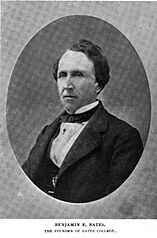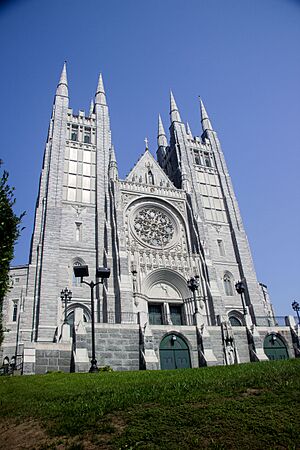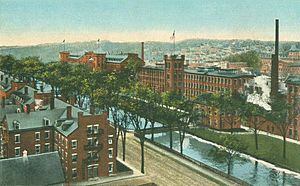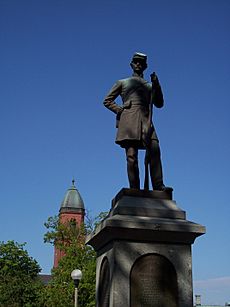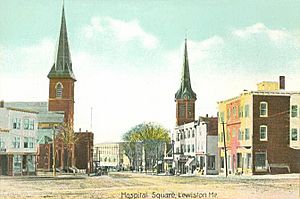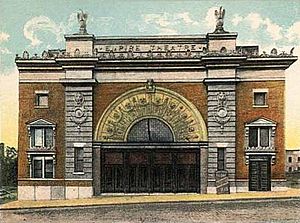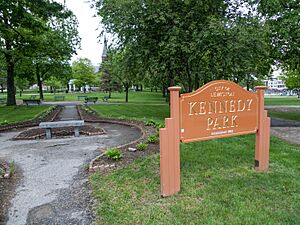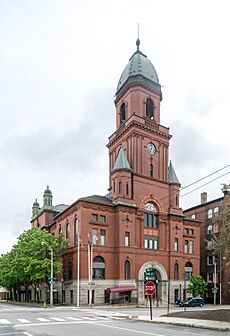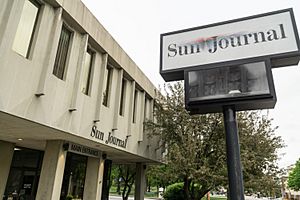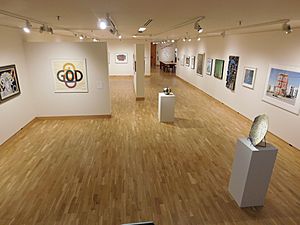Lewiston, Maine facts for kids
Quick facts for kids
Lewiston, Maine
|
||
|---|---|---|

Top: Civil War Memorial Statue, Bates College's Hathorn Hall; Bottom: the Wallace School, Kennedy Park and Lewiston City Hall
|
||
|
||
Nickname(s):
|
||
| Motto(s):
Industria (Latin)
"Industry" |
||
| Country | United States | |
| State | Maine | |
| County | Androscoggin | |
| Incorporated | 1795 (as Lewistown) 1863 (as Lewiston) |
|
| Village | South Lewiston | |
| Government | ||
| • Type | City council | |
| Area | ||
| • Total | 35.54 sq mi (92.03 km2) | |
| • Land | 34.15 sq mi (88.44 km2) | |
| • Water | 1.39 sq mi (3.60 km2) 4% | |
| Elevation | 217 ft (66 m) | |
| Population
(2020)
|
||
| • Total | 37,121 | |
| • Density | 1,087.13/sq mi (419.74/km2) | |
| • Demonym | Lewistonion | |
| Time zone | UTC−5 (EST) | |
| • Summer (DST) | UTC−4 (EDT) | |
| ZIP Code |
04240, 04241, 04243
|
|
| Area code | 207 | |
| FIPS code | 23-38740 | |
Lewiston is the second-largest city in Maine, a state in the United States. In 2020, about 37,121 people lived here. The city is located right between Augusta, which is Maine's capital, and Portland, its biggest city. Lewiston is part of Androscoggin County. It forms a twin city area with Auburn, often called "L/A."
Lewiston is important for its diverse community, many different religions, businesses, and schools. It's known for having a low cost of living and good access to medical care. The city has been growing a lot recently. Most people speak English, but there's a large Somali community. Lewiston also has the biggest French-speaking population in the U.S. by total number of people.
The area around Lewiston was first home to the Androscoggin tribe in 1669. In 1795, the town was officially named Lewistown. The Androscoggin River and its waterfalls made it a great spot for factories and water-powered businesses. A rich businessman named Benjamin Bates helped the city grow very quickly.
Many Irish immigrants came to build railroads and dig canals for the textile mills. They stayed and worked in the mills, starting their own businesses. Later, thousands of French-speaking people from Quebec moved to Lewiston, causing the population to boom.
In 1855, a preacher named Oren Burbank Cheney started the Maine State Seminary. This was the first college in New England that allowed both boys and girls to study together. It was also one of the first to accept Black students before slavery ended. Lewistown became known for its focus on education. In 1864, it officially became the city of "Lewiston."
Today, Lewiston is home to the only basilica in Maine, the Basilica of Saints Peter and Paul. It also has five colleges, many historic places, and two major hospitals.
Contents
History of Lewiston
Early Beginnings
Before Europeans arrived, the Lewiston area was home to the Androscoggin tribe. They were part of the Abenaki nation. In the 1600s, these Native Americans were among the first to meet European settlers in Maine. But as more colonists arrived, conflicts grew. Diseases also greatly reduced the tribe's numbers. Because of this, many Androscoggin people moved to New France (now Canada) starting in 1669. By 1680, they had left Maine completely.
Colonial Settlement
In 1768, a large piece of land where Lewiston now stands was given to Moses Little and Jonathan Bagley. They named the new settlement Lewistown. Paul Hildreth was the first person to settle there in 1770. By 1795, Lewistown officially became a town. Some houses from this early period are still standing today and are listed as historic places.
Streets like King Avenue and Ralph Avenue were named after Ralph Luthor King, who owned land nearby. Elliott Avenue was named after his wife, Grace O. Elliott.
Growth of Industry and Benjamin Bates
Lewiston started as a small farming town. But in the early 1800s, people realized that the Androscoggin River was perfect for powering factories. In 1809, Michael Little built a large sawmill by the waterfalls. Later, in 1836, local business owners created a company to build dams, canals, and mills.
Investors from Boston became interested. One important person was Benjamin Bates, a powerful businessman in textiles and railroads. Bates came to Lewiston and helped fund the Lewiston Water Power Company. This company built the city's first canal. In 1850, about 400 Irish men came from Boston to dig the canal system.
Bates was impressed by the hard work of the people in Lewiston. He then started the Bates Manufacturing Company. This led to the building of five large mills, starting with Bates Mill No. 1. The mills used the power from Lewiston Falls. During the Civil War, these mills made textiles for the Union Army. Bates's mills created thousands of jobs for Irish, Canadian, and other European immigrants. For 30 years, the Bates Mill was Maine's largest employer.
Lewiston changed from a small farming town into a major textile manufacturing center, similar to Lowell, Massachusetts. The city became very wealthy, and some fancy neighborhoods were built. Even though most people were working class, a rich upper class also grew. The Bates Mill remained the biggest employer in Lewiston until the mid-1900s.
Railroads were also very important for Lewiston and Auburn. In 1849, a railroad connected Lewiston to other towns and to a line between Portland and Montreal. Many Irish laborers built these railroads. By 1854, one-fourth of Lewiston's population was Irish. Trains then brought people from Quebec to Lewiston every day.
During the Civil War, the high demand for textiles helped Lewiston's factories grow even stronger. However, the wealth of Benjamin Bates also led to some problems, like the 1861 Lewiston cotton riots. After this, Bates gave money back to the city and created more jobs in his mills.
In 1861, many French-Canadian immigrants started moving to Maine. They came for factory jobs that used water power. These French-speaking workers from Quebec joined Irish immigrants and local mill girls. Lewiston's population grew from 1,801 in 1840 to 21,701 in 1890. The French-Canadians settled in an area downtown called Little Canada. Since then, Lewiston has had a strong Franco-American culture.
In 1855, the Maine State Legislature approved the founding of the Maine State Seminary. This school opened in 1855. It offered education to working-class people in Maine. It also educated Black students and women when many other universities did not. It was the first college in New England to be coeducational. In 1864, the school was renamed Bates College in honor of Benjamin Bates.
In 1863, Lewiston officially became a city. In 1872, St. Peter's Church was built. This was the first French-Canadian church in Maine. In 1880, a French-language newspaper called Le Messager started printing in Lewiston.
The Church of Saints Peter and Paul was built between 1905 and 1938. It was paid for by many small donations from Lewiston residents. It is the largest Catholic church in Maine and a famous landmark. In 2004, it became a basilica.
Challenges and Changes
After World War I, textile factories in New England, including Lewiston, started to make less money. Businesses began moving to the southern U.S. because it was cheaper to get power, transport materials, and pay workers there.
Starting in the late 1950s, many of Lewiston's textile mills closed down. This made the downtown area look run-down. Big stores like Woolworth's and J.C. Penney closed or moved to malls outside the city. As jobs left, people also started to move away. The city's population slowly went down after 1970.
New Growth and Revival
After a tough time in the 1980s with high unemployment, Lewiston began to grow again. A big part of this was the Bates Mill Complex. The city took over the complex in 1992. In 2001, the city sold some mill buildings to private developers. These developers fixed up the buildings, and new businesses moved in. The Bates Mill complex was added to the National Register of Historic Places in 2010.
In 2004, city leaders announced a plan to improve the downtown area. They wanted to tear down old millworker homes and build new streets and housing. This plan led to cooperation between residents and city officials. They worked together to redesign Kennedy Park, adding new basketball courts and a large skate park.
New businesses have opened downtown, including a headquarters for Oxford Networks and a campus for Kaplan University. The old Maine Supply Co. building was renovated and is now a business center.
Lewiston's revival has been recognized nationally. In 2007, Lewiston won the All-America City Award. This award recognizes cities where people work together to solve problems and achieve great results.
Somali and Bantu Communities
In 1999, the U.S. government started to resettle about 12,000 refugees from Somalia in different cities. Many first went to Clarkston, Georgia. But they often ended up in poor areas. So, many started looking for new places to live.
News spread that Lewiston had low crime and affordable housing. In 1999, Somali people began moving to Lewiston. After 2005, many Somali Bantus, another ethnic group, also moved there.
In 2002, the mayor, Laurier T. Raymond, wrote an open letter to Somali leaders. He worried about the impact on city services and asked them to discourage more people from moving to Lewiston. This letter caused a lot of discussion and brought national attention to the city.
In 2003, a small group of white nationalists came to Lewiston to protest against Somali immigrants. This led to a much larger counter-protest at Bates College. About 4,000 people, including the governor and senators, gathered to support the Somali community.
By 2010, the Lewiston Sun Journal newspaper reported that Somali business owners were helping to bring life back to downtown Lewiston. They opened shops in empty storefronts. Somali farmers have also helped local agriculture.
Somali-American players have also helped the Lewiston High School boys' soccer team win state championships in 2015, 2017, 2018, and 2023.
National Historic Places
Lewiston has many buildings and places listed on the National Register of Historic Places. These include:
- Androscoggin Mill Block
- Atkinson Building
- Bergin Block
- Bradford House
- Captain Holland House
- College Block-Lisbon Block
- Continental Mill Housing
- Cowan Mill
- Dominican Block
- Dr. Louis J. Martel House
- Dr. Milton Wedgewood House
- First Callahan Building
- First McGillicuddy Block
- First National Bank
- Grand Trunk Railroad Station
- Hathorn Hall, Bates College
- Healey Asylum
- Holland-Drew House
- James C. Lord House
- John D. Clifford House
- Jordan School
- Kora Temple
- Lewiston City Hall
- Lewiston Public Library
- Lewiston Trust and Safe Deposit Company
- Lord Block
- Lower Lisbon Street Historic District
- Lyceum Hall
- Maine Supply Company Building
- Manufacturer's National Bank
- Marcotte Nursing Home
- Oak Street School
- Odd Fellows Block
- Osgood Building
- Pilsbury Block
- Philip M. and Deborah N. Isaacson House
- Saint Mary's General Hospital
- Savings Bank Block
- Second Callahan Block
- Sen. William P. Frye House
- St. Joseph's Catholic Church
- Basilica of Saints Peter and Paul
- Trinity Episcopal Church
- US Post Office-Lewiston Maine
- Union Block
Geography of Lewiston
Lewiston covers about 35.54 square miles. Most of this is land, with a small amount of water. The Androscoggin River forms the city's western edge. Lewiston is next to Auburn across the river. It also borders the towns of Greene, Sabattus, and Lisbon.
City Neighborhoods
Downtown Lewiston
Downtown Lewiston is the most crowded part of the city. It has many homes and businesses, especially on Lisbon Street and Main Street. This area used to be the main business hub for the whole county. After the factories closed, some parts became run-down. But now, many buildings are being fixed up and new life is coming back to the area.

Important places in Downtown Lewiston include:
- Lisbon Street Business District
- Country Kitchen Bread Factory
- Tree Street Youth Center
- Lewiston City Hall
- Lewiston Public Library
- Bates Mill Complex
- The Root Cellar
- Kennedy Park
- The Public Theatre
- S.S. Peter and Paul Basilica
- Agora Grand Event Center, once St. Patrick's Church
- St. Joseph's Church
- Central Maine Medical Center
- Railroad Park
- Androscoggin Bank Colisée
- Webb's Market
- Farmers Market
Webster Street Area
This neighborhood has mostly suburban homes for middle-income families. It is located between Lisbon and Webster Streets, East Avenue, and Alfred Plourde Parkway. Students here go to Farwell Elementary, Martel Elementary, Lewiston Middle School, and Lewiston High School.
Pond Road Area
This area is shaped like a triangle by Pond Road, Randall Road, and Sabattus Street. It is also mostly suburban homes for middle-income families. McMahon Elementary, Lewiston Middle School, and Lewiston High School serve this neighborhood.
Lewiston's Climate
Lewiston has a humid continental climate. This means temperatures change a lot throughout the year. Summers are usually short, warm, and humid. Winters are very cold, long, and snowy. Lewiston gets about 74 inches of snow each year, but this can change a lot. Snow is common from late November to late March. Sometimes, freezing rain or sleet can also happen in winter. Summers are usually pleasant, but high humidity can make it feel hotter. Strong summer storms like tornadoes are rare.
Economy and Jobs
Major Businesses
- Central Maine Medical Center: This hospital was started in the 1860s. It is downtown on High Street. It has about 250 beds and 300 doctors. It is a major trauma center. The hospital also runs a nursing college and other clinics.
- Country Kitchen Bakery: This bakery is downtown. It is owned by Flowers Foods and sells bread across the U.S.
- Walmart Distribution Center: Walmart has a very large warehouse in Lewiston. It is the biggest facility of its kind in Maine. This center sends food to all Walmarts in New England.
- Sun Journal: This is a daily newspaper based on Park Street. It prints news for central and western Maine. It is the third-largest newspaper in the state.
- Modula - System Logistics: This company designs and builds automated storage equipment for warehouses.
- Sazerac Company: This company owns Boston Brands of Maine. They bought the White Rock bottling plant in Lewiston. They now produce Fireball Cinnamon Whiskey there.
Shopping and Dining
- Downtown Lisbon Street: This street is the business and government center of Lewiston. It has many law offices, the city library, and the district court. You can also find Senator Susan Collins' office here. There are many shops and restaurants, including some started by the Somali community. Downtown Lisbon Street also hosts the Emerge Film Festival and Art Walks in the summer.
- Upper Lisbon Street: Further up Lisbon Street, you'll find several malls, like the Lewiston Promenade Mall. There are also many chain restaurants, car dealerships, and other private businesses.
Main Street Area
U.S. Route 202 and Maine State Routes 11 and 100 all run along Main Street.
- Downtown Main Street: Main Street begins near the downtown area at the Governor James B. Longley Memorial Bridge. As you cross into Lewiston, you'll see Veterans Memorial Park. This park honors all veterans. There's also a small hydro-plant that used to power the textile mills. The downtown section of Main Street has the L.L. Bean Call Center, a TD Bank branch, and Central Maine Medical Center.
- Upper Main Street: Beyond downtown, this area has some businesses and chain stores, but it's mostly residential. The street is lined with large, old Victorian houses. Some are still homes, while others have become doctors' offices.
Top Employers
Here are the top employers in Lewiston, based on a 2022 report:
| # | Employer | # of Employees |
|---|---|---|
| 1 | Central Maine Medical Center | 2,135 |
| 2 | Sisters of Charity Health Systems | 1,169 |
| 3 | TD Bank | 989 |
| 4 | Bates College | 947 |
| 5 | Wal-Mart Stores | 622 |
| 6 | McKesson | 380 |
| 7 | Lepage Bakeries | 375 |
| 8 | Sazerac/Boston Brands of Maine | 279 |
| 9 | Androscoggin Home Health | 273 |
| 10 | State of Maine | 250 |
Arts and Culture
Libraries and Museums
- The Lewiston Public Library is very important to Lewiston's culture. It was updated in 1996 and has over 150,000 items. It also has the Marsden Hartley Cultural Center, which hosts concerts, talks, and film festivals.
- Museum L-A: This museum is in an old textile factory. It celebrates the people who worked and lived in Lewiston. Visitors can see how things were made in the textile, shoe, and brick industries. The museum is in Bates Mill Number 4.
- The Bates College Museum of Art shows many different kinds of art. Art students from Bates College contribute a lot to the city's art scene.
- The Atrium Gallery: This gallery is at the University of Southern Maine campus in Lewiston. It also features a wide range of art.
Performance Venues
- The Franco Center: This center opened in 2000 in a former church. It hosts performances related to Franco-American culture and other cultural events. It also serves as a museum about the city's Franco-American history.
- The Public Theatre: Lewiston has The Public Theatre, which puts on different plays throughout the year. It features actors from all over the world.
Local Events
Emerge Film Festival
The Emerge Film Festival started in 2014. It shows films in downtown Lewiston and Auburn.
The Great Falls Balloon Festival
The Great Falls Balloon Festival happens every August. Hot air balloons are launched, and there are games and carnival rides. People come from all over to see the balloons.
Festival Franco
This festival celebrates Lewiston's Franco-American heritage. It features French-Canadian musicians and food.
Liberty Festival
On July 4th, the Liberty Festival celebrates with fireworks over the Great Falls of the Androscoggin River. You can watch the fireworks from Veterans Park and Railroad Park.
Patrick Dempsey Challenge
Lewiston hosts the annual Dempsey Challenge, which began in 2009. This event is a run/walk and cycling fundraiser for cancer research. It's hosted by actor Patrick Dempsey, who is from Lewiston. All the money raised goes to the Patrick Dempsey Center for Cancer Hope at the Central Maine Medical Center.
Sports and Fun
The Androscoggin Bank Colisée
The Androscoggin Bank Colisée is the main sports center in Lewiston. It used to be home to the Lewiston Maineiacs, a major junior hockey team. The Colisée also hosts the state high school hockey championships every year. Lewiston is known for its love of hockey, partly because of its French American heritage. Two Lewiston schools, Lewiston High School and St. Dominic Regional High School, have won many state high school hockey championships.
The Maine Nordiques, a junior hockey team, have played their home games at the Colisée since 2019.
Famous Boxing Match
In May 1965, Lewiston was the site of a famous boxing match between Muhammad Ali and Sonny Liston. Ali had beaten Liston before, and this was a rematch. The fight was supposed to be in Boston but was moved to the Colisée in Lewiston. It had the lowest attendance ever for a heavyweight championship match, with only 2,434 fans. This fight is famous for the photo of Ali standing over Liston. Ali won by knockout in the first round.
Baseball in Lewiston
Lewiston has a history with minor league baseball. The Lewiston Twins and other teams played here from 1891 to 1930. Baseball Hall of Fame member Jesse Burkett managed the Lewiston Twins in 1928 and 1929.
Hockey Teams
- The Maine Nordiques were a professional hockey team that played in Lewiston from 1973 to 1977.
- The Lewiston Maineiacs were a major junior hockey team that played in Lewiston from 2003 to 2011. They were the only team in their league from the United States. They won a championship in 2007. Several players from the Maineiacs later played in the National Hockey League.
- The Lewiston/Auburn Nordiques were a junior hockey team that played from 2018 to 2020.
- The Maine Nordiques (2019–present) are a current junior hockey team that plays at the Androscoggin Bank Colisée. The team is coached by Nolan Howe, whose grandfather was the famous hockey player Gordie Howe.
Education
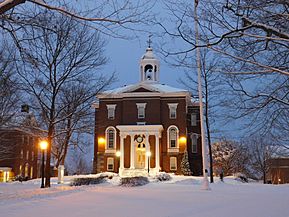
Lewiston's public school system has five elementary schools, one middle school, and one high school. It also has a technical center for students from different school districts. Some of the school buildings are quite new.
Colleges and Universities
- Maine College of Health Professions
- Bates College
- University of Southern Maine – Lewiston/Auburn Campus
- Central Maine Community College – Auburn
Public Schools
Lewiston Public Schools runs these schools:
- Lewiston High School (grades 9–12)
- Lewiston Regional Technical Center (grades 9–12)
- Lewiston Middle School (grades 7–8)
- Farwell Elementary School (grades K–6)
- Raymond A Geiger Elementary School (grades K–6)
- Robert V. Connors Elementary School (grades K–6)
- Montello School (grades K–6)
- Thomas J McMahon Elementary School (grades K–6)
Private Schools
- The Discovery School (PK-12)
- Saint-Dominic Academy
- Vineyard Christian School (PK-12)
Charter Schools
- Acadia Academy (PK-6)
Media
Newspapers
- The Sun Journal prints a daily newspaper. It has won awards for being a top newspaper in New England and Maine.
- Lewiston Evening Journal was a newspaper that ran from 1866 to 1989.
- The Twin City Times is a free weekly newspaper that covers local news.
Radio Stations
Five radio stations are based in Lewiston:
- WARX/93.9: Plays religious music.
- WIGY/1240: Plays adult contemporary music.
- WFNK 107.5: Branded as 107.5 Frank FM, plays classic hits.
- WLAM 1470: Plays older songs, branded as The Memories Station.
- WRBC 91.5: This is the college radio station for Bates College.
Television
Lewiston is part of the Portland television market. This means it receives all the major TV channels from that area. Two local news channels, WGME-TV and WCSH, have offices in Lewiston.
City Infrastructure
Transportation
Public Transit
Lewiston uses the Citylink, or Purple Bus, system. This bus system also serves Auburn and Lisbon. The downtown shuttle connects both Lewiston and Auburn. Citylink serves about 235,000 people each year.
Roads and Highways
- Interstate 95 / Maine Turnpike: This major highway runs through Lewiston. Exit 80 connects to the city's Industrial Park. I-95 links Lewiston to Portland (40 minutes away), Bangor (90 minutes away), and Boston (about two hours away).
- U.S. Route 202 / Maine State Routes 11 and 100: These routes run along Main Street through Lewiston. They connect the city to Auburn and Greene. They also provide quick travel to Augusta.
- Maine State Route 196: This route starts in Lewiston as Canal Street, then becomes Lisbon Street. It connects Lewiston to Lisbon, and then to Topsham and Brunswick.
- Maine State Route 126: This route starts in Lewiston as Sabattus Street. It connects Lewiston to the town of Sabattus.
Bridges
- Vietnam Veterans Memorial Bridge: Built in 1973, this bridge connects Lewiston to Auburn.
- Governor James B. Longley Memorial Bridge: This bridge connects Main Street in downtown Lewiston to Court Street in downtown Auburn. It is named after former Lewiston resident and Maine Governor James B. Longley.
- Bernard Lown Peace Bridge: This bridge connects the Little Canada area of Lewiston to New Auburn. It is named after former Lewiston resident and Nobel Peace Prize winner Bernard Lown.
Airports and Bus Stations
- Auburn/Lewiston Municipal Airport: This is the official airport for both cities. It mainly handles private planes. For commercial flights, most people use the Portland International Jetport.
- Oak Street Bus Station: Greyhound Lines operates a bus service from Lewiston. You can take buses to Bangor and Boston, and from there, travel to more places.
- Concord Coach Lines: This service provides direct bus transportation from Great Falls Plaza/Bates College to Logan International Airport and South Station in Boston.
Hydroelectric Power
Lewiston has several hydroelectric dams on the Androscoggin River. These dams generate electricity using the flow of water.
- The Gulf Island hydroelectric dam is operated by Brookfield White Pine Hydro and Central Maine Power Company.
- The Deer Rips hydroelectric dam is also operated by Brookfield White Pine Hydro and Central Maine Power Company.
- The Charles E. Monty hydroelectric dam is another dam operated by Brookfield White Pine Hydro and Central Maine Power Company.
Notable People from Lewiston
Lewiston has been home to many interesting people over the years. Some famous individuals include:
- Muhammad Ali, a famous boxer who had a fight in Lewiston.
- Patrick Dempsey, an actor who hosts a cancer research fundraiser in Lewiston.
- Benjamin Bates IV, a businessman who helped build Lewiston's textile industry.
- Oren Burbank Cheney, who founded Bates College.
- James B. Longley, a former Governor of Maine.
- Bernard Lown, a doctor who won the Nobel Peace Prize.
- Jesse Burkett, a Baseball Hall of Fame member.
See also
 In Spanish: Lewiston (Maine) para niños
In Spanish: Lewiston (Maine) para niños





